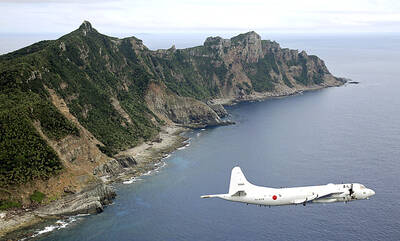The Ministry of National Defense plans to use a proposed aerospace and uncrewed aerial vehicle (UAV) industry campus to produce military drones, a defense official said yesterday.
The campus in Chiayi County’s Minsyong Township (民雄) would receive nearly NT$6.9 billion (US$216.12 million) to build factories, hangars and UAV testing facilities, the ministry’s budget proposal submitted last month to the Legislative Yuan showed.
The Chungshan Institute of Science and Technology, the ministry’s research and development arm, is to oversee the project, it said.

Photo: Yu Tai-lang, Taipei Times
Speaking on condition of anonymity, the defense official said the information disclosed by the report suggested that the campus would serve as the production center for drones, the military value of which has rapidly increased in the past few years.
The Teng Yun 2 (騰雲二型, “Cloud Rider 2”) and the Albatross II (銳鳶二型), the nation’s domestically developed medium-altitude long-endurance military drones, have passed operational tests, the official said, adding that the Teng Yun 2 last month participated in a live-fire precision-guided munition exercise.
The Albatross II reportedly performed well in the drills, although the armed forces have yet to issue a contract for mass production of the drone, they said.
The Chien Hsiang (劍翔, “Rising Sword”), a loitering munitions drone that targets radar systems, is believed to be slated for mass production next year, and would be funded through the regular budgetary process rather than the Sea-Air Combat Power Improvement Plan, they said.
The navy has also proposed a budget for the Hung Chueh 3 (紅雀三型, “Cardinal 3”) project to address flaws with its predecessor, the Hung Chueh 2 (紅雀二型), such as a lack of target designation capabilities, training simulators and dedicated trainer drones, the official said.
The Executive Yuan approved the drone budgets one day after approving a high-profile warship and submarine budget, which shows the urgency and importance that it has placed on improving the capabilities of the military’s UAVs, they said.
In May, the Cabinet approved the Five Trusted Industry Sectors development plan targeting chips, artificial intelligence, defense, security and surveillance, and next-generation communications.
The plan’s defense component includes funds to boost the nation’s UAV design and production capabilities with an emphasis on establishing supply chains outside of China, it said at the time.
The Executive Yuan’s 2028 targets for the drone industry include increasing the sector’s value 10-fold to NT$30 billion and a surge production capability of 15,000 systems a month.

MISINFORMATION: The generated content tends to adopt China’s official stance, such as ‘Taiwan is currently governed by the Chinese central government,’ the NSB said Five China-developed artificial intelligence (AI) language models exhibit cybersecurity risks and content biases, an inspection conducted by the National Security Bureau (NSB) showed. The five AI tools are: DeepSeek, Doubao (豆包), Yiyan (文心一言), Tongyi (通義千問) and Yuanbao (騰訊元寶), the bureau said, advising people to remain vigilant to protect personal data privacy and corporate business secrets. The NSB said it, in accordance with the National Intelligence Services Act (國家情報工作法), has reviewed international cybersecurity reports and intelligence, and coordinated with the Ministry of Justice Investigation Bureau and the National Police Agency’s Criminal Investigation Bureau to conduct an inspection of China-made AI language

LIMITS: While China increases military pressure on Taiwan and expands its use of cognitive warfare, it is unwilling to target tech supply chains, the report said US and Taiwan military officials have warned that the Chinese People’s Liberation Army (PLA) could implement a blockade within “a matter of hours” and need only “minimal conversion time” prior to an attack on Taiwan, a report released on Tuesday by the US Senate’s China Economic and Security Review Commission said. “While there is no indication that China is planning an imminent attack, the United States and its allies and partners can no longer assume that a Taiwan contingency is a distant possibility for which they would have ample time to prepare,” it said. The commission made the comments in its annual

‘TROUBLEMAKER’: Most countries believe that it is China — rather than Taiwan — that is undermining regional peace and stability with its coercive tactics, the president said China should restrain itself and refrain from being a troublemaker that sabotages peace and stability in the Indo-Pacific region, President William Lai (賴清德) said yesterday. Lai made the remarks after China Coast Guard vessels sailed into disputed waters off the Senkaku Islands — known as the Diaoyutai Islands (釣魚台) in Taiwan — following a remark Japanese Prime Minister Sanae Takaichi made regarding Taiwan. Takaichi during a parliamentary session on Nov. 7 said that a “Taiwan contingency” involving a Chinese naval blockade could qualify as a “survival-threatening situation” for Japan, and trigger Tokyo’s deployment of its military for defense. Asked about the escalating tensions

DISPUTE: A Chinese official prompted a formal protest from Tokyo by saying that ‘the dirty head that sticks itself out must be cut off,’ after Takaichi’s Taiwan remarks Four armed China Coast Guard vessels yesterday morning sailed through disputed waters controlled by Japan, amid a diplomatic spat following Japanese Prime Minister Sanae Takaichi’s comments on Taiwan. The four ships sailed around the Senkaku Islands — known as the Diaoyutai Islands (釣魚台) to Taiwan, and which Taiwan and China also claim — on Saturday before entering Japanese waters yesterday and left, the Japan Coast Guard said. The China Coast Guard said in a statement that it carried out a “rights enforcement patrol” through the waters and that it was a lawful operation. As of the end of last month,